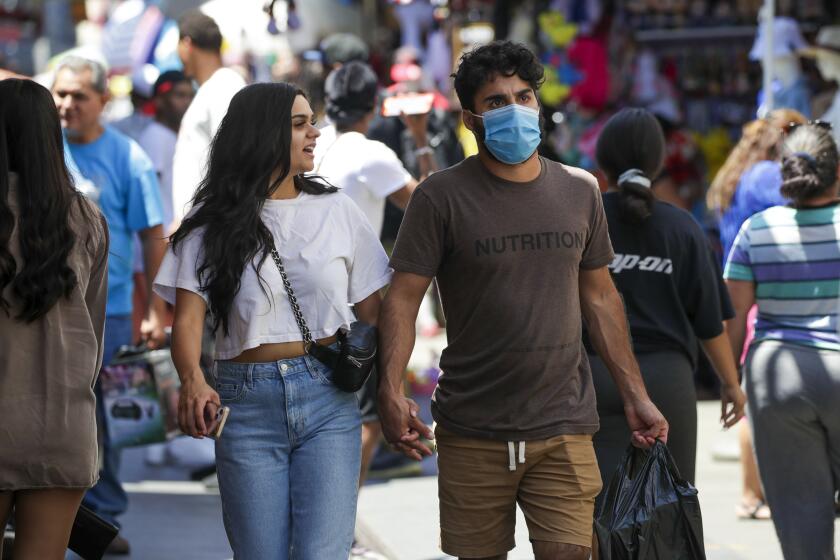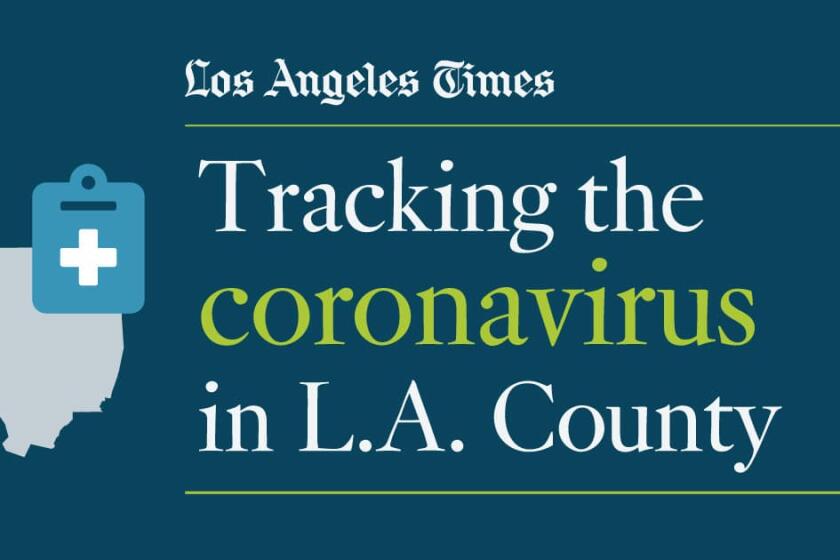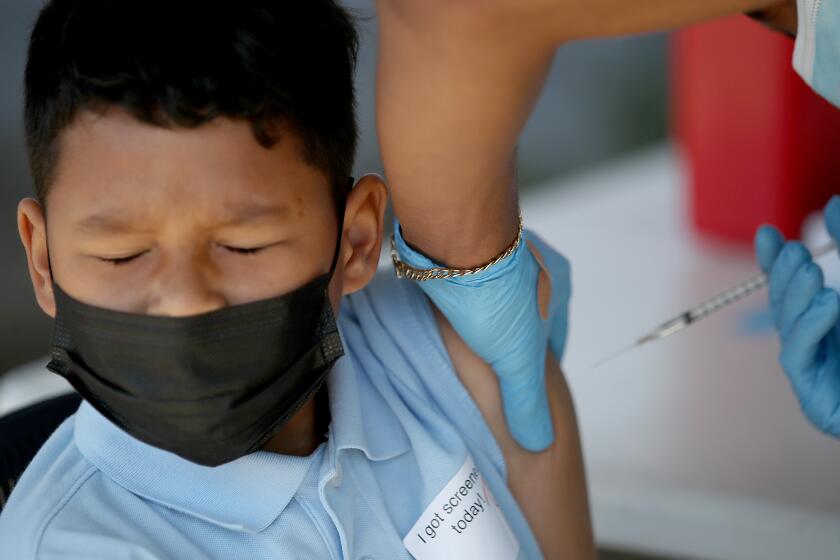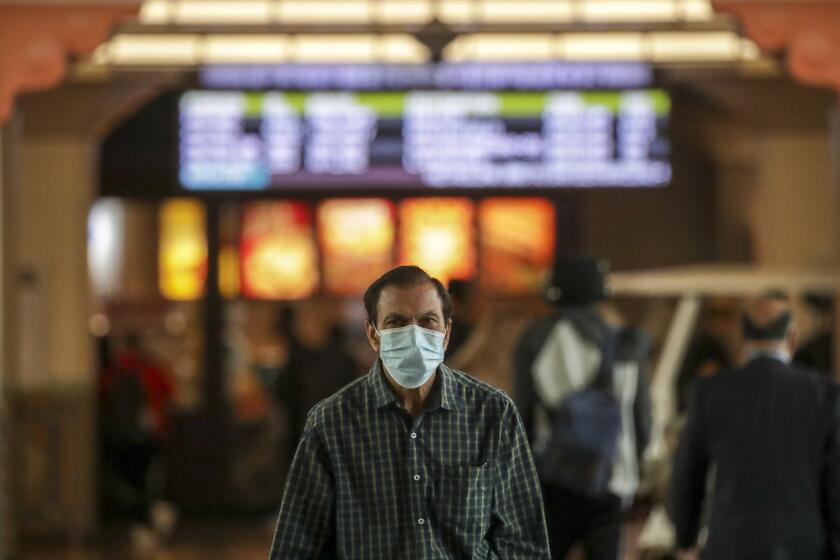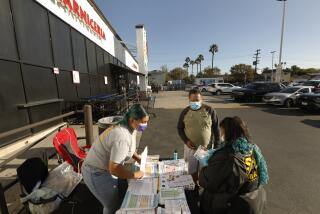L.A. County drops out of high COVID-19 level as surge eases
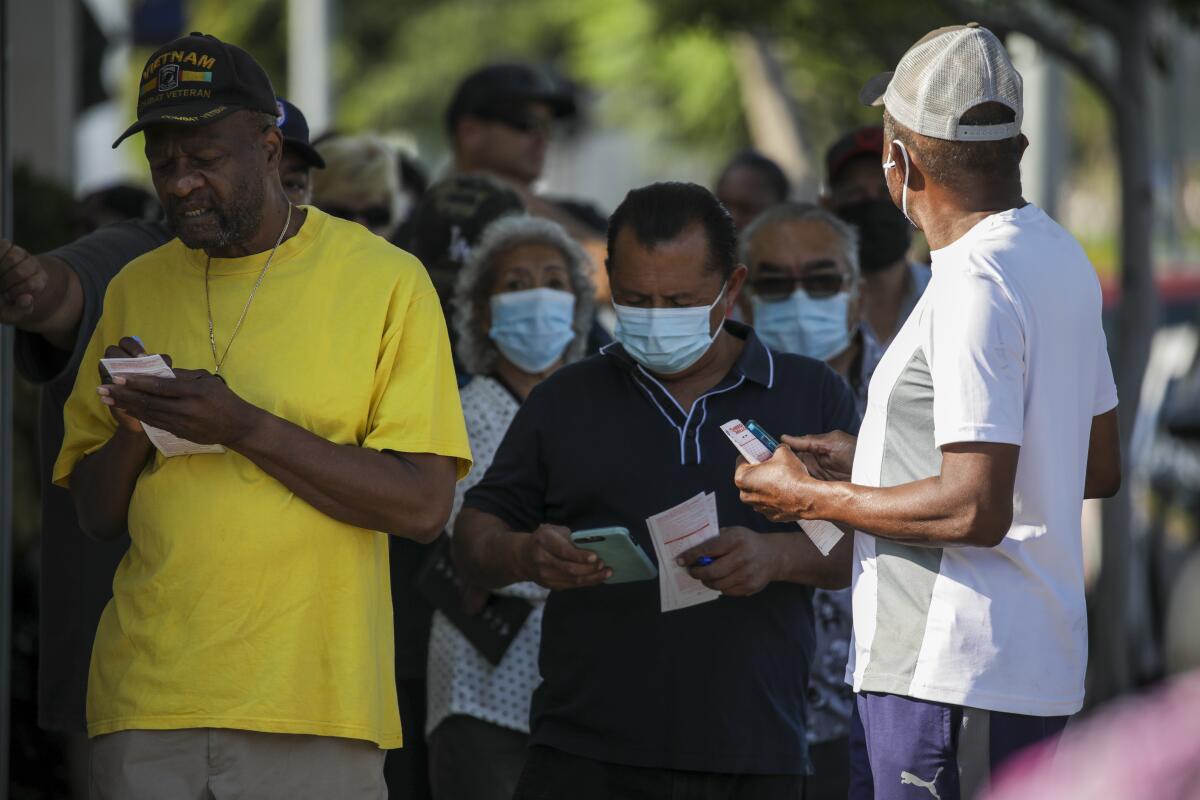
Los Angeles County officially moved out of the high COVID-19 community level Thursday as one top state health official expressed hope that California is at the end of the pandemic’s latest wave.
Officials continue to urge caution, noting that coronavirus case rates remain high and still strongly recommend universal masking in indoor public spaces as schools resume classes.
Still, L.A. County’s move from the high to medium level, as defined by the U.S. Centers for Disease Control and Prevention, underscores the recent promising trends in the nation’s most populous county — which prompted officials to drop plans for a renewed mask mandate late last month.
“While we’re greatly encouraged by the decline in cases, hospital admissions and deaths, because viral transmission remains high, there are still thousands of new people each day who are infected and therefore capable of infecting others,” L.A. County Public Health Director Barbara Ferrer said.
Since getting infected causes disruption among families and at workplaces, “and, for some, becoming infected can lead to debilitating illness, we advise caution and ongoing use of a layered approach for reducing the risk of exposure and preventing severe illness,” she added Thursday.
Health officials recommend that anyone infected with the coronavirus isolate for at least 5 days — but for many, that timeline may be overly optimistic.
A primary prong of that is vaccination. Focus is now turning to the prospect of an Omicron-specific booster that may be authorized in late September and available for administration in October, ahead of a potential fall-and-winter wave. It’s unclear, however, what age groups would be eligible for that additional dose.
For the seven-day period that ended Thursday, L.A. County has reported an average of about 3,800 new coronavirus cases per day — down 23% from the prior week, according to a Times analysis of county data.
On a per-capita basis, that’s 263 cases a week per every 100,000 residents. The summer’s peak rate was 476, logged between July 12 and July 18. A case rate of 100 or more is considered a high rate of transmission.
The number of coronavirus-positive individuals hospitalized countywide also has started to fall significantly. As of Wednesday, 1,098 such individuals were in L.A. County’s hospitals — down 17% from this wave’s July 20 peak.
The latest maps and charts on the spread of COVID-19 in Los Angeles County, including cases, deaths, closures and restrictions.
The number of coronavirus-positive intensive care unit patients also has begun to fall. There were 125 as of Wednesday, down 15% from the summer’s July 27 peak.
Weekly COVID-19 deaths may also be starting to flatten or drop. L.A. County reported 96 COVID-19 deaths for the week that ended Thursday, down from a summer peak of 122 for the weekly period that ended Saturday.
To move from the high to medium COVID-19 community level, L.A. County had to record fewer than 10 new weekly coronavirus-positive hospital admissions per every 100,000 residents. The county came oh-so-close last week, recording a rate of 10.1, according to the CDC.
The most recent assessment released Thursday had a similarly razor-thin margin but in the other direction, with the CDC pegging the county’s rate at 9.9.
Originally, Ferrer had said that a new indoor mask order would go into effect if the county reached the high community level and remained there for three consecutive Thursdays. But on the pivotal date — July 28 — she scuttled that possibility, citing marked improvements in coronavirus case and hospitalization rates.
Some officials and experts have predicted a potential rebound in coronavirus transmission as children and staff return for the new school year. Ferrer, though, noted that “we’re in a much better place than we were a year ago in this pandemic.”
“We have vaccines available for all children ages 6 months and older, we have good access to therapeutics and testing, and a wealth of knowledge about this virus,” she said. “Our school districts have gained a great deal of experience and expertise in managing COVID risks on the campus.”
Among the strategies health officials recommend are staying up to date on vaccinations, improving indoor air quality, promoting good hand hygiene and supporting access to testing.
The overall number of Californians living in counties with a high COVID-19 community level also dramatically fell Thursday. There were only 37% of California residents in counties at that level, a substantial drop from the prior week’s proportion of 74%. There were 21 California counties in the high COVID-19 community level, down from 28 the prior week.
Nine counties exited the high level this week: Los Angeles, San Diego, San Francisco, Sonoma, Imperial, Sutter, Lake, Calaveras and Modoc. Two entered the high level: Santa Barbara and San Luis Obispo.
In Southern California, Orange and Ventura counties remain in the high level; while Riverside and San Bernardino counties remain in medium. Some of the most populous counties in Northern California and the Central Valley, however, remained in the high COVID-19 community level, including Santa Clara, Alameda, Contra Costa, Fresno, San Mateo, San Joaquin, Stanislaus, Solano and Monterey.
The trends in L.A. County largely mirror those statewide. Over the weeklong period ending Monday, California reported an average of 12,750 new coronavirus cases per day — a decrease of 26% from the prior week, according to state data compiled by The Times. On a per capita basis, California is recording 228 cases a week for every 100,000 residents.
Coronavirus-positive hospitalizations across California are also down markedly, from more than 4,800 in late July to 4,030 as of Wednesday; coronavirus-positive ICU patients are down from a summer peak of 571 to 484.
“I think we’re hopefully at the tail end now of this most recent surge,” state epidemiologist Dr. Erica Pan said during a panel discussion Tuesday.
With the worst of the wave now seemingly in the rearview mirror, it’s becoming increasingly clear the major uptick in transmission — fueled by subvariants in the super-contagious Omicron family — did not wreak the same sort of havoc on hospitals as earlier surges.
Though new infections rose to among the highest of the pandemic, as some experts suggested based on wastewater data, the number of coronavirus-positive hospital patients remained comparatively low.
“While we did see a lot of transmission here in California with these new subvariants of Omicron again, thankfully, the hospitalizations have been low and stable,” Pan said.
Emerging evidence suggests that catching the coronavirus a second time can heighten long-term health risks.
Unlike earlier surges, a significant amount of those patients this time around — including 57% in L.A. County — were not hospitalized for COVID-19 illness but happened to incidentally test positive after seeking care for some other reason.
Experts and officials largely credit the wider disconnect between case counts and hospitalizations with increased vaccination and COVID-19 treatments. Changes in the coronavirus itself also may have played a role, as there are some indications that Omicron and its subvariants cause milder symptoms for many than preceding variants.
Promisingly, the variant outlook remains relatively stable. The dominant Omicron subvariant, BA.5, now accounts for an estimated 87% of coronavirus cases nationwide for the week that ended Saturday, a slight increase from the prior week’s estimate of 85%.
“It’s possible that these findings may be heralding a saturation of our population with this subvariant,” Ferrer said.
Some officials had been worried about the growth rate of another subvariant, BA.4.6, but its prevalence was largely stable in the last week. And another that has raised concerns in India, BA.2.75, has been identified in only two people in L.A. County.
With the latest wave continuing to recede both in California and across the country, the CDC on Thursday released new, loosened guidelines regarding what unvaccinated people should do if they’re exposed to a coronavirus-infected person. The CDC’s action essentially brought federal guidance — which, until Thursday, had been more restrictive than California’s and called for those people to quarantine as they waited to see if they would test positive or develop symptoms — to a roughly similar level as that in place for the state and Los Angeles County.
California recommends that everyone exposed to someone with a coronavirus infection — defined as sharing the same indoor space with an infected person for at least 15 minutes over a 24-hour period — need only mask up for 10 days following exposure, and test three to five days after their last exposure. If symptoms develop or a test result is positive, they need to isolate.
Californians who develop COVID-19 illness or test positive should stay home for at least five days after the onset of symptoms or a positive test result. They can exit isolation as early as Day 6 if they get a rapid negative test result on Day 5 or later, but should wear a mask around other people until the end of Day 10. They generally can exit isolation on Day 11 without needing a negative test result, unless a fever remains or symptoms are not resolving.
Despite all the relatively rosy news on the pandemic front, California’s weekly COVID-19 death tally is still climbing, and rose to 304 for the week that ended Monday, the highest tally this summer. Still, the latest figure is far less than previous waves. The summer of 2020 peaked at 1,024 weekly deaths, and the summer of 2021 with 945 weekly deaths. During the first pandemic winter, there were 3,815 deaths during the worst week; and the worst weekly death tally last winter was 1,827.
California has reported more than 93,000 COVID-19 deaths since the pandemic began. Nearly 29,000 deaths have been reported in the last 12 months.
The U.S. has reported more than 1 million COVID-19 deaths, with nearly 400,000 in the last year. As in California, national weekly deaths are lower this summer compared with the prior summer.
“If we continue on the trajectory we’re on for death rates, this is where we’d end up — with about 100,000 deaths per year [nationally], which is three times more than influenza deaths per year. So that’s still substantial mortality,” UC San Francisco epidemiologist Dr. George Rutherford said at a panel discussion last week.
More to Read
Start your day right
Sign up for Essential California for news, features and recommendations from the L.A. Times and beyond in your inbox six days a week.
You may occasionally receive promotional content from the Los Angeles Times.
